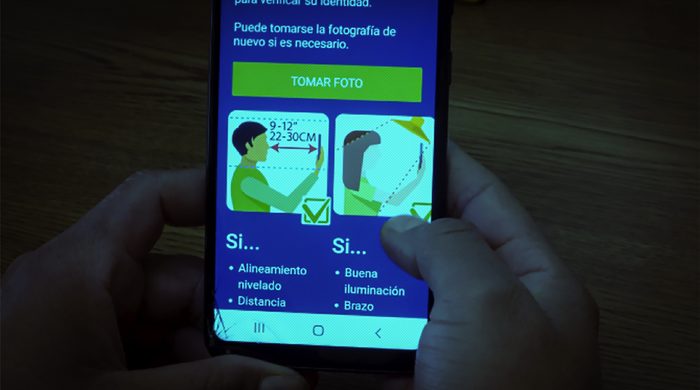The App ICE Forces You To Download
Under Biden, monitoring of immigrants by cell phone has jumped 808%.
Maurizio Guerrero

When you are in a process like this one, all of your body shivers, every bit of yourself shakes, because you do not want to make mistakes to be again at risk of being detained or deported,” says Carlos, whose name has been shortened to avoid affecting his immigration case. “It wears you out.”
Carlos settled in Fontana, Calif., coming from Chimalhuacán, on the outskirts of Mexico City, in 2002. But after a misdemeanor in 2019, Carlos was subject to deportation proceedings. He was imprisoned for three months, electronically shackled for more than a year, and, in January 2021, ordered to install an app on his phone so that Immigration and Customs Enforcement (ICE) agents could check in on him.
The app uses voice recognition and geolocation to verify that Carlos is at home, which ICE says helps ensure his “compliance with release conditions.” People in deportation cases are required to live at one permanent address and alert ICE if they move.
In an initially weekly (now monthly) check-in, an automated voice asks him to state his name and repeat five digits. The app is notoriously buggy. “If it doesn’t detect your voice then it says, ‘We couldn’t make out what you said,’ and they order you to let your deportation officer know,” Carlos says. “One has to immediately call to let them know what is going on. … The first time it happened to me, I felt they were coming for me.”
Carlos’ daughters also live in fear that one day Carlos will simply not come home from work. They have welcomed him home in tears on days he takes longer than usual to arrive. Their teachers say they are distracted in class and their academic performance has dropped, and the school has recommended therapy.
Carlos’ weekly app check-ins have also hampered his ability to get and keep a job. “On the day they call, they just call once,” Carlos explains. He knows the day but never knows the time — simply a window to be at home, from, say, 7 a.m. to 5 p.m., he says.
“You are missing days of work,” Carlos says, “so which kind of employer would want a worker like that? … So when work slacks a little bit, we are the first ones to be laid off.”
Carlos doesn’t tell his coworkers he even has to use the app, because “they would have fear and they would even distance themselves from me” if they knew, he says, because ICE has been known to use geotracking data from electronic monitoring to conduct workplace raids. “If they track me down and my colleagues do not have documents, it is obvious that they will be affected,” Carlos explains.
A May report, commissioned by 13 immigrant rights organizations, found in interviews with immigrants that ICE’s app “causes deep anxiety about ICE’s access to personal lives and a constant sense of being watched.” It adds the anxiety is especially intense for “communities of color who are overwhelmingly subjected to [ICE’s electronic monitoring] and targeted by all forms of law enforcement more broadly.” And, importantly, “In addition to limiting a person’s livelihood, the fear of constant monitoring silences family ties, organizing efforts and the ability for immigrants to speak freely and advocate for themselves and their communities.”
AMPLE DISCRETION
Founded in 2004 without transparency or external oversight, ICE’s Intensive Supervision Appearance Program (ISAP) has quietly mushroomed from an $11 million budget in fiscal year 2005 to $475 million in 2022. All of that money for immigrant surveillance, all from the Department of Homeland Security (DHS), benefits only one company: BI Incorporated, founded in 1978 as a cattle monitoring company.
BI now monitors 296,250 immigrants — like Carlos— ordered by ICE agents to wear electronic shackles or check in through its SmartLINK phone app.
BI won its 2004 ICE contract over the nonprofit Vera Institute of Justice. Vera offered a case management approach to deportation proceedings, helping people find legal aid, translation services, housing and medical care. Without any electronic monitoring, Vera had achieved a 90% hearing attendance rate in a three-year pilot with ICE, compared with 71% for those outside the program.
In 2011, BI was acquired by infamous private prison corporation GEO Group. The company says it provides “high quality case management” but, according to a March investigation by The Guardian, case managers sit in a round-the-clock call center tracking as many as 300 people simultaneously. They “often don’t have enough time to offer immigrants tailored support … and are even discouraged by managers from doing so,” according to The Guardian.
In a June program assessment report to Congress, the Government Accountability Office found ICE’s oversight of BI to be spotty and opaque. While there was no transparent rubric or reporting of the program’s effectiveness, the Government Accountability Office estimated, for example, that as many as a quarter of participants moved without giving ICE a change of address. (Asked about the report, DHS pointed to the GAO’s finding that the department is working to fix most of the problems identified.
Despite the lack of evidence of efficacy, ICE has added more than 200,000 people to the number of immigrants it surveils through these alternative-to-detention tools during the Biden years, up from 86,860 in January 2021, according to data compiled by the Syracuse University project TRAC. This increase is primarily driven by an 808% jump in the use of the SmartLINK app. The use of shackles or ankle monitors — the alternative-to-detention choice of the Trump administration, which caused electrical shocks, physical harm, social isolation, unemployment and even suicidal thoughts — has been reduced by half, to 14,901, while SmartLINK monitors 241,614 people.
The enormous growth of the Alternatives to Detention Program has not meant an emptying of immigration prisons. ICE states prominently on the program’s website that it is “not a substitute for detention,” and the number of immigrants in physical custody in July was 23,886, up from 14,195 in the final month of the Trump administration.
Anil Kalhan, a law professor at Drexel University, is the author of a seminal 2014 paper on electronic surveillance in immigration enforcement. The government decided to institute these tools, Kalhan says, “but there is not much transparency in what they’re doing, no clear legal authorization, no clear oversight, and therefore there’s not really much by way of accountability for misuse.”
ICE field agents decide who is to be detained, released, shackled or electronically monitored, and they do so with ample discretion. The Government Accountability Office report found a lack of oversight to ensure decision-making protocols were followed or to check for racial bias. A 2021 study by the Benjamin Cardozo School of Law in New York, for example, found that, of 1,119 people in the program, Black immigrants were twice as likely as others to be subject to e-shackling.

TRUST US, SAYS ICE
Questions abound regarding what happens with the data BI and ICE collect. Some electronic monitoring companies and law enforcement agencies do share collected personal data, including GPS location data. For example, at the massive fusion center in Arlington, Va. — a post 9/11 intelligence sharing hub used by 25 local and federal enforcement agencies — D.C.’s Metropolitan Police Department shares GPS data from its parolee tracking program, VeriTracks.
Created by Securus Monitoring, VeriTracks allows law enforcement to run automatic searches comparing “crime scene information with GPS tracking data from probationers and other personnel who are being monitored and tracked by GPS devices,” according to a hacked internal MPD document published in 2021 by the transparency collective Distributed Denial of Secrets. “If a tracked person is identified to be near a crime incident at the approx time of the incident, a ‘hit’ occurs and the proper officials are notified by email.” Civil society group ICE Out of DC is especially concerned about data use by the Department of Homeland Security, which shares offices with the fusion center.
ICE and BI claim SmartLINK’s capabilities, such as face and voice recognition and geolocation, are restricted to check-in calls, which leaves the public simply to trust that “ICE is complying with its own representation,” says Julie Mao, co-founder of Just Futures Law, a women-led law project advocating for immigrants’ rights. “There is no policy, manual or law restricting how and when ICE tunes in or listens into the application,” Mao says. A joint media investigation by Documented NY and The Markup concluded, in June, that the SmartLINK app can actually access location, camera, voice-recording and external storage data on a person’s phone, as well as read phone numbers and make external calls without the user’s permission.
In an online fact sheet, GEO Group deems it “a myth” that BI misuses data collected through electronic monitoring and denies it conducts “surveillance” activities. BI’s contract with ICE stipulates that data is to be stored only on the user’s phone and that all data is ICE’s property, not BI’s, stresses GEO Group. In an email to In These Times, Monica Hook, a GEO Group spokesperson, writes that BI “does not record participant audio or video, regardless of user-approved permissions,” and referred to the SmartLINK privacy policy.
Whatever records ICE does keep about SmartLINK, ICE has refused to release them. In April, the Samuelson Law, Technology and Public Policy Clinic at the University of California, Berkeley, filed a complaint on behalf of the nonprofits Community Justice Exchange, Just Futures Law and Mijente — after ICE refused to comply with a Freedom of Information Act request to provide “records regarding the collection of data from the SmartLINK application; the retention, sharing, and use of such data; and, the nature of monitoring through the application.” The litigation is pending in federal court.
This opacity itself contributes to a “chilling” effect on immigrants, according to Mao. Carolina Sanchez Boe, a scholar at Aarhus University in Denmark studying digital detention, has arrived at a similar conclusion, saying that SmartLINK provokes a fear “of putting people in danger, whether they are relatives or coworkers.” And that fear is rooted in reality: In 2019, for example, ICE used electronic tracking of undocumented immigrants to arrest 680 poultry plant workers in Mississippi in the largest immigration raid of a U.S. workplace in more than a decade.
“People are really afraid of endangering others,” Sanchez Boe says.

FOLLOWING THE MONEY
Julio’s coworkers know he has an automated check-in call with SmartLINK every Tuesday between 9 a.m. and 1 p.m.
“When the phone rings, they tell me, ‘Take the photo, because if you’re not going to send that photo, we’re all in danger here,’ ” explains Julio, a pseudonym he requested pending his asylum case. “They say that as a joke, but in the end they do it with a bit of fear, because they are also undocumented.”
According to Julio, an ICE agent ordered him to have his phone’s geolocation service on uninterruptedly. “If the location is turned off, the program is disconfigured,” Julio says. At least 10% of SmartLINK users are permanently on GPS, GEO Group acknowledged on its fact sheet.
Julio left La Ceiba, Honduras, with his wife and 12-year-old daughter because he was unable to gather the money a gang was extorting from his three businesses — a car wash, laundry and cafe. Julio knew of a woman who had been killed after her husband, another small business owner, was unable to pay the gang. In 2018, after traveling more than 2,000 miles, Julio and his family requested asylum in the United States, citing credible fears of gang violence.
As they moved through asylum hearings, Julio and his wife were first electronically shackled for about a year; then, she was relieved from the check-ins and he was ordered to check in weekly through SmartLINK.
“You only get five attempts to send them a picture, but sometimes the pictures fail all five attempts,” Julio says in a phone interview from Chicago, where he lives now.
He says he finds it hard to believe the United States is spending money on surveilling him, considering the huge incentive he has to appear at his court dates.
ISAP monitoring — including telephone check-ins, shackles and SmartLINK — costs about $1,600 per immigrant annually, according to Homeland budget documents.
Julio also finds it troubling that “companies are making millions out of this.”
BI has been awarded three of the top 10 ICE contracts of the past three years, and it is now ICE’s second-largest contractor — second only to parent company GEO Group. In 2020, BI, whose only business is immigrant surveillance, won a five-year, $2.2 billion ICE contract, the most recent order of which was placed August 1, well into the Biden administration. BI has received $1.51 billion from ICE so far.
Parent company GEO Group, meanwhile, donated $4.2 million to campaigns and elected officials in the 2020 election cycle — the largest amount the company has ever given to politicians and lobbying. In 2021 and 2022 (so far), GEO Group has spent $1.4 million on lobbying, mostly to the House and Senate appropriations committees, which are in charge of funding government contracts.
For the 2023 fiscal year budget, Homeland requested $527 million — an $87 million increase from the previous budget — for its “continued expansion” of ICE’s electronic monitoring program. The House Appropriations Committee not only approved it but added $10 million to the request. Reuters, meanwhile, reports the government intends to electronically surveil up to 400,000 immigrants by September 2023, on track with the current growth rate of 10,000 more people each month.
These projections are good news for GEO Group as almost a quarter of its income came from the privately operated federal prisons that Biden is phasing out; its main business — operating immigration detention centers — is also declining. The current number of immigrant detainees has decreased to fewer than half of the almost 56,000 detained at the height of the Trump administration (which, in its final year, was forced to release tens of thousands of detained individuals because of issues related to the pandemic). While Congress pays GEO Group by the bed (regardless of whether the beds are occupied), the 2023 budget includes plans to reduce detention beds from 32,500 to 25,000, a $271.2 million decrease.
In response, GEO Group is actively trying to move its business toward electronic surveillance. “Our growth is generally dependent upon our ability to obtain new contracts to offer electronic monitoring,” as well as community-based reentry services and monitoring and supervision, the company stated in its most recent annual report.
But a push to control SmartLINK’s expansion is on the way. In February, a group of 25 Democrats in Congress, led by Michigan Rep. Rashida Tlaib, sent a letter to Alejandro Mayorkas, secretary of the Department of Homeland Security, requesting to “significantly reduce the number of individuals” subjected to electronic monitoring, to publicly disclose the data collected through this program and to reevaluate its contracts with BI. Homeland has not publicly responded to the letter and did not reply to repeated requests for comment.
Advocates’ goal is to create a genuinely fair and humane immigration system, as Biden promised in his presidential campaign. Meanwhile, a 2019 report by the National Immigrant Justice center cites ample evidence that community-based and community-supported alternatives to detention, run by nonprofit organizations under a case management model, maintain an average compliance rate of 90% (or higher) with a price tag as much as 80% less than traditional detention.
As for oversight and transparency, “I do want to underscore that the Biden administration could choose to be more transparent on its own,” Drexel professor Anil Kalhan says. “Nothing is stopping the Biden administration from beginning a process of developing a more transparent and regularized governing legal framework for this program and many others like it.”
Maurizio Guerrero is a journalist based in New York City. He covers migration, social justice movements and Latin America.









